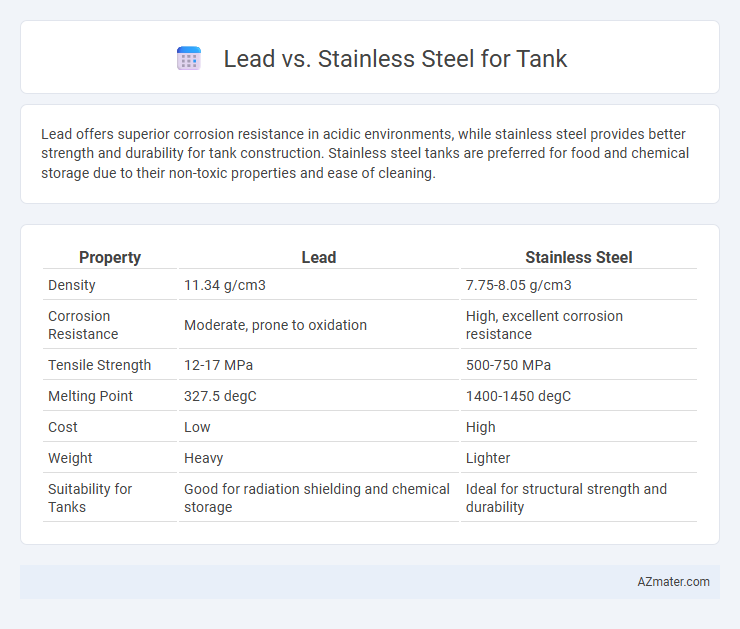Lead offers superior corrosion resistance in acidic environments, while stainless steel provides better strength and durability for tank construction. Stainless steel tanks are preferred for food and chemical storage due to their non-toxic properties and ease of cleaning.
Table of Comparison
| Property | Lead | Stainless Steel |
|---|---|---|
| Density | 11.34 g/cm3 | 7.75-8.05 g/cm3 |
| Corrosion Resistance | Moderate, prone to oxidation | High, excellent corrosion resistance |
| Tensile Strength | 12-17 MPa | 500-750 MPa |
| Melting Point | 327.5 degC | 1400-1450 degC |
| Cost | Low | High |
| Weight | Heavy | Lighter |
| Suitability for Tanks | Good for radiation shielding and chemical storage | Ideal for structural strength and durability |
Introduction to Lead and Stainless Steel Tanks
Lead tanks provide excellent corrosion resistance and chemical durability, making them suitable for storing acidic or corrosive substances. Stainless steel tanks offer superior strength, hygiene, and resistance to oxidation, ideal for food processing, pharmaceuticals, and chemical industries. Both materials serve distinct industrial applications based on their properties and compatibility with stored substances.
Material Overview: Lead vs Stainless Steel
Lead offers excellent corrosion resistance and density, making it useful for radiation shielding and chemical storage tanks, but it is heavy and toxic. Stainless steel provides superior strength, durability, and resistance to oxidation and high temperatures, ideal for food processing, pharmaceutical, and chemical industries. Material selection depends on application requirements such as weight constraints, chemical compatibility, and regulatory standards.
Strength and Durability Comparison
Stainless steel exhibits superior strength and durability compared to lead, making it a preferred material for tank construction in demanding environments. Stainless steel's tensile strength ranges from 485 to 620 MPa, far exceeding lead's approximate tensile strength of 12 to 18 MPa, ensuring enhanced structural integrity under pressure. Moreover, stainless steel resists corrosion, oxidation, and wear much better than lead, extending the tank's service life and reducing maintenance costs significantly.
Corrosion Resistance and Longevity
Lead exhibits exceptional corrosion resistance in acidic and sulfurous environments due to its passive oxide layer, making it highly durable for specific chemical storage tanks. Stainless steel offers superior overall longevity and corrosion resistance across diverse environments, including oxidizing and chloride-rich conditions, thanks to its chromium content forming a robust passive film. Choosing between lead and stainless steel for tanks depends on the stored substance's chemical properties and desired service life.
Safety and Health Implications
Lead tanks pose significant health risks due to lead's toxicity, which can leach into stored liquids, causing poisoning and long-term health problems such as neurological damage. Stainless steel tanks are corrosion-resistant and non-reactive, ensuring safer storage without the risk of contaminant leaching, making them the preferred choice for food, beverage, and chemical industries. Regulatory agencies strongly discourage the use of lead in tanks for potable water or consumables to protect human health and maintain safety standards.
Cost Analysis: Lead vs Stainless Steel
Lead tanks generally have a lower upfront material cost compared to stainless steel, making them more budget-friendly for initial investment. However, stainless steel tanks offer superior durability and corrosion resistance, leading to lower maintenance and replacement expenses over time. When factoring in lifecycle costs, stainless steel often proves more cost-effective despite higher initial expenses due to its extended longevity and reduced downtime.
Environmental Impact and Sustainability
Lead tanks pose significant environmental hazards due to lead's toxicity, which can leach into soil and water, causing long-term contamination and health risks. Stainless steel tanks offer superior sustainability by being fully recyclable, resistant to corrosion, and requiring less frequent replacement, minimizing waste production. Their durability and non-toxic properties contribute to a lower environmental footprint and safer handling throughout their lifecycle.
Maintenance Requirements and Lifespan
Lead tanks require frequent inspection and maintenance due to their susceptibility to corrosion and potential lead contamination, necessitating regular lining replacement. Stainless steel tanks exhibit superior corrosion resistance, significantly reducing maintenance frequency and costs, with an expected lifespan exceeding 30 years under normal operating conditions. The durability of stainless steel minimizes downtime, making it a more cost-effective choice for long-term storage solutions compared to lead.
Industry Applications for Each Material
Lead tanks are extensively used in chemical processing industries due to their exceptional resistance to corrosive acids and alkalis, making them ideal for handling strong chemicals and waste. Stainless steel tanks dominate in food and beverage, pharmaceutical, and water treatment sectors because of their durability, non-reactive surface, and ease of sanitation. The choice between lead and stainless steel tanks hinges on the specific chemical compatibility needs and regulatory standards of the industrial application.
Choosing the Right Tank Material for Your Needs
Lead tanks offer superior corrosion resistance and are ideal for storing aggressive chemicals, while stainless steel tanks provide excellent durability and hygiene for food, pharmaceutical, and beverage industries. Consider factors such as chemical compatibility, temperature tolerance, and budget constraints when selecting between lead and stainless steel. Stainless steel's resistance to contamination and ease of cleaning often make it the preferred choice for applications requiring strict sanitary standards.

Infographic: Lead vs Stainless Steel for Tank
 azmater.com
azmater.com